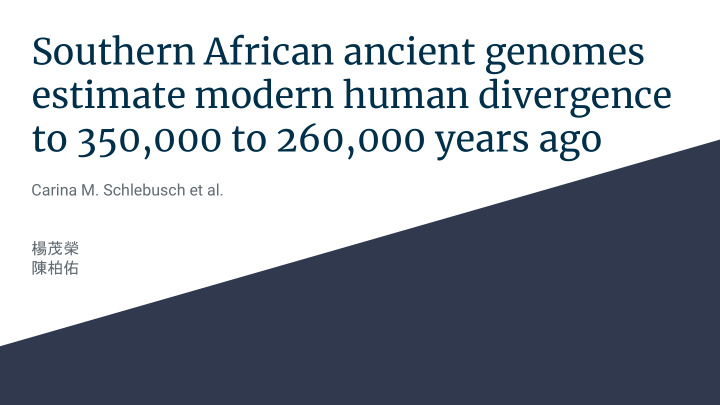



Southern African ancient genomes estimate modern human divergence to 350,000 to 260,000 years ago Carina M. Schlebusch et al. 楊茂榮 陳柏佑
anatomically (解剖學上的) modern humans When does anatomically modern humans appears?
When does Anatomically modern humans appears? In archeology, In genetics, we find some early fully we try to calculate the modern human remains and distance between modern determinate the age of the humans and estimate the remain by Half-life deepest split time (which determination. means their common ( 半衰期測定 ) ancestor) by mutation rate.
The earliest The Oldest Fossil ( 化石 ) modern human Remains of Anatomically remain Modern Humans. - Omo remains It is estimated to be there about 195,000 years ago. Was discovered between 1967 and 1974 at the Omo Kibish sites near the Omo River, Ethiopia.
Estimation by Genetics
Intuition of 1. Find 2 groups of modern humans, both of them have obvious modern human features. Estimation by Genetics
Intuition of 1. Find 2 groups of modern humans, both of them have obvious modern human features. 2. Estimate the age of their common ancestor, the Estimation by ancestor must have modern human features already. Genetics 150000 years Now
Intuition of 1. Find 2 groups of modern humans, both of them have obvious modern human features. 2. Estimate the age of their common ancestor, the Estimation by ancestor must have modern human features already. Genetics 3. The farther distance between two picked groups, the better. 280000 years Now
Khoe-San Genetic studies identified modern southern African Khoe-San populations as carrying more unique variants and more divergent lineages than other living groups.
Khoe-San Genetic studies identified modern southern African Khoe-San populations as carrying more unique variants and more divergent lineages than other living groups. PCA of ancient southern Africans and a global comparative data set.
Modern Bantu-language-speaking group They origin from Nigeria and Cameroon, and start to migrate at around 3000 years ago. They reach South Africa at around 1700 years ago.
Modern Bantu-language-speaking group Nowadays, They distributed across Central Africa and South Africa. Their gene is very different from Khoe-Sans.
Middle Stone Age sites in KwaZulu-Natal, South Africa The author studied: 3 stone age hunters / gatherers, about 2000 years old. 4 iron age farmers, about 300~500 years old.
Middle Stone Age sites in KwaZulu-Natal, South Africa Modern Khoe-San Modern Bantu- language-speaking groups
Middle Stone Age sites in KwaZulu-Natal, South Africa Modern Khoe-San Consistent with the archeology evidence that Bantu-language-speaking groups moved to South-East Africa around 1700 years ago. Modern Bantu- language-speaking groups
Middle Stone Age sites in KwaZulu-Natal, South Africa Modren Khoe-San Bantu-language-speaking groups and Iron age farmers not only have similar gene, but also have similar distance to Khoe-San Modern Bantu- language-speaking groups
Admixture of Modern Khoe-San Also by Genetics, Modern Khoe-San are now know to be mixed with Ju|’hoansi / Nama at around 1500 / 1300 years ago. These people are hordes ( 遊牧民族 ) distributed in South Africa. wiki: Ju ǀ 'hoan dialect The admixture would disarrange the estimation of common ancestors.
Middle Stone Age sites in KwaZulu-Natal, South Africa X Modern Khoe-San Ballito Bay A’s gene Modern Bantu- language-speaking groups
High-quality Genome Sequencing 1. Using B. Bay A Boy & 1. Using B. Bay A Boy & Bantu. Bantu. 2. Assuming 1.25 * 2. Assuming 1.25 * 10^-8 mutations per 10^-8 mutations per generation. generation. -> The deepest split time: 285~356ka.
Two plus Two(TT) method
Brief Summary (So far) 1. B. Bay A v.s. Dinka -> deepest split among modern demonstrating the deepest humans occurred at between split at >260 ka. 350 and 260 ka 2. Ju|’hoansi v.s. Dinka 258~255 Consistent; with the opening of ka. Middle Stone Age
Conclusion Archaeological, fossil, and genetic records increasingly point toward a modern human development that includes southern Africa.
Recommend
More recommend